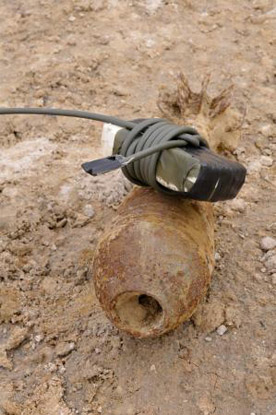Explosive ordnance disposal exercise displays transition progress
Afghan culture is based primarily on trust. To build an effective partnership with the people in Afghanistan is to earn their trust. The same can be said about working with explosives, as the team relies on an enormous amount of trust.

In a successful operation on 15 March, members of the Afghan National Army and International Security Assistance Force (ISAF) troops safely disposed of unexploded ordnance.
The 18 mortar shells were located by the Afghan National Army (ANA) Route Clearance Company in an undisclosed area. As the shells could be moved from the location, the unexploded ordnance still posed a possible hazard, so the ANA explosive ordnance disposal unit was contacted to make certain the threat was eliminated.
Cooperation and trust
As part of an ongoing relationship between the ANA 209th Corps and ISAF, training is provided on many levels to prepare ANA soldiers in the proper identification, diffusion and disposal of the dangerous munitions which are found in Afghanistan.
Unexploded ordnance can be handled in a number of ways, depending on many factors. Some are extremely volatile and moving them would cause serious safety issues, so they are generally blown in place. Others can be safely handled and removed, but still require disposal which needs a controlled detonation. Through the cooperation between the U.S. Navy Explosive Ordnance Disposal Mobile Unit 3 and the ANA’s 209th Corps, a controlled detonation was set up to perform a check on training and the safe disposal of the mortar shells.

“The benefit to this event is that the ANA guys have different levels of knowledge of EOD,” said Petty Officer 2nd Class Aaron Helmer of the Mobile Unit 3. “This is a perfect opportunity to see the skill level of all of them and to see how well they are retaining what they have been taught.”
Both teams convoyed to the safe remote area used for controlled detonation and worked together to properly handle and set the demolitions. At the site, the mixed groups separated into three different teams to demonstrate the different basic techniques for the safe disposal of ordnance.
ANA trainers taking the lead
Helmer's team utilised a mainline – branch line, a way to clear explosives from a narrow pathway. Petty Officer 2nd Class Jonathan Tsui organised what is called a ring – mainline, which is used to clear large areas and Lt. Romesh Haytasingh, the EOD Mobile Unit 3 commander, conducted the organised demolition, used to control the blast and inhibit unnecessary damage to the immediate area.
While giving the hands-on education to the ANA through translators, the trainers realised that the essential knowledge was present in each of the groups, as the ANA counterparts took charge in the instruction.
“We got to a point, where we could stop talking and just act as observers,” said Tsui. “They knew the basics and we had the opportunity to blend in and perform the safety checks for the work they were doing.”
After the teams completed the set-up of the detonations, the demolition leader, Petty Officer 2nd Class Ben Johnson carefully inspected the blast area for any safety hazards and to make certain the group’s efforts have been properly performed. He ordered the blast lines to be connected and to be extended to the designated safe area where the team would be protected from possible stray blast fragments yet be able to inspect the detonations from a distance.
“Fire in the hole, fire in the hole, fire in the hole,” warned everyone of the imminent blasts. Each blast was an audible and visual acknowledgment of a successful detonation. After the blasts, Johnson walked to each location to verify the completion of the event. On his return, the group gathered for a follow-up assessment of the activity.
Building expertise
At the end of the exercise, the teams returned to their respective bases to carry out follow-on briefings for assessment from all participants. During the post-blast brief, Lt. Haytasingh shared his evaluation of the event.
“The most successful part of the day was having one of the ANA guys step up and take over the training,” Haytasingh said. “It shows these guys are taking the training and applying it. They are also teaching it to their counterparts.”
In a country which has seen conflict for nearly 30 years, the landscape is littered with remnants of planted explosive devices and unexploded ordnances. The tasks of handling these explosives are usually the responsibility of highly-trained explosive ordnance disposal technicians. As training continues, increasing numbers of the ANA are trained in explosive ordnance disposal fundamentals, and are taking the lead in the safe disposal of ordnance.
